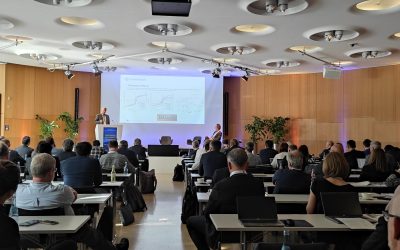PASSENGER study demonstrates water-resistant alternatives to rare earth magnets
Every journey toward sustainability begins with a challenge. For magnets, this challenge is creating alternatives to rare earth elements that can withstand real-world conditions. The PASSENGER research team has tackled this by developing and testing new magnets with promising results.
Our recent comprehensive study on manganese-aluminum-carbon (Mn-Al-C) magnets investigated their chemical, physical, and magnetic properties, with a particular focus on corrosion resistance. The tests demonstrated that these innovative magnets maintain remarkable stability during extended water exposure, opening possibilities for transforming applications from water pumps to other aqueous environments.
From challenge to solution
Among the alternatives that do not contain rare earth elements, Mn-Al materials stand out as a particularly promising solution. What’s truly exciting about these magnets is their environmental footprint. According to the research team, we can produce them with readily available materials using scalable, low-cost manufacturing techniques, while still achieving impressive durability in everyday applications.
“We are essentially creating a middle ground,” explains Dr. Semih Ener from the Technical University of Darmstadt, who led the research. “These magnets have the potential to bridge the gap between basic ferrite magnets and high-performance rare earth magnets, offering a sustainable alternative for many common applications.”
Testing the waters
The team conducted a rigorous four-week testing program using multiple analytical techniques to evaluate the long-term effect of exposure to different environments on the material properties. They exposed the magnets to different aqueous solutions – from regular tap water to specially purified water and selected acidic solutions – and monitored their response. Using specialized equipment and electron microscopy, researchers tracked changes in the magnets’ structural integrity and magnetic properties. The sample magnets, made from manganese and aluminum with small amounts of carbon (Mn-Al-C), showed remarkable stability in regular water conditions during the testing period. This characteristic makes them particularly suitable for applications like water pump motors, electric bikes, and other devices where exposure to moisture is common.
However, the study also revealed some limitations. While the magnets performed well in regular water, they showed vulnerability to saltwater and low pH conditions, with noticeable degradation occurring in these environments. The researchers suggest that additional protective measures, such as specialised coatings, might be necessary for more demanding environments – a challenge they are already working to address.
Why it matters
The timing of this research is particularly relevant as global markets grapple with rare earth element supply chains. Traditional high-performance magnets rely heavily on rare earth elements, primarily sourced from a limited number of countries, leading to price volatility and supply chain vulnerabilities. Europe’s dependency on these materials is particularly acute – the region currently imports nearly 98% of its rare earth magnet needs, making the development of alternatives a strategic priority.
Mind the Gap
The implications of this research extend beyond just technical achievements. As the world moves toward electrification and sustainable energy, the demand for magnets continues to grow. Electric vehicles, wind turbines, and countless everyday devices rely on permanent magnets. Having a middle-range option – a “gap magnet” as researchers call it for use in applications where high-performance is not required – that doesn’t depend on rare earth elements could help diversify the supply chain and reduce environmental impact.
“We are not suggesting these will replace high-performance rare earth magnets in all applications,” the team clarifies. “But for many everyday uses where top-tier performance isn’t critical, these could offer a more balanced, sustainable and affordable alternative.”
The road ahead
While the study results are promising, the research team is already looking to the future. Through the EU-funded PASSENGER project (Pilot Action for Securing a Sustainable European Next Generation of Efficient RE-free magnets) and the RecycleTEAM project, researchers are exploring ways to enhance these magnets’ performance in more challenging environments and bring them from laboratory success to real-world implementation.
Want to be part of this journey?
- Explore detailed findings: Rocabert, U., Parnicki-Krollik, M. A., Maccari, F., Tankov, N., & Ener, S. (2025). Comprehensive Study of τ-Phase Mn–Al–C Magnets: Corrosion Resistance, Structural Integrity, and Magnetic Properties. ACS Omega, 10(1), 683-691. https://doi.org/10.1021/acsomega.4c07540
- Connect with the study’s corresponding author: Semih Ener at semih.ener[at]tu-darmstadt.de
- Recommended reading: PASSENGER factsheet #2: Navigating the EU path in securing Critical Raw Materials (CRMs) for a sustainable future
Acknowledgements
This research was performed within the European Union Horizon 2020 research and innovation programme through the project PASSENGER (Pilot Action for Securing a Sustainable European Next Generation of Efficient RE-free magnets) under grant agreement No 101003914 and the RecycleTEAM project (Project-ID 30EN2056D).




